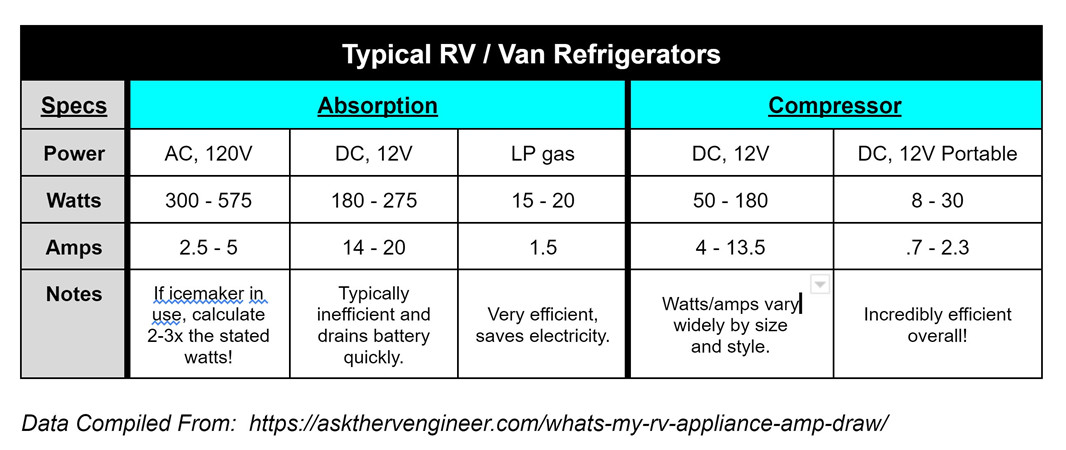Can I Run my RV Fridge on Battery While Driving?
Yes! You can run a fridge off of a battery while driving and while off-grid camping, but there are several factors that you need to consider to determine if you have enough battery power to do so. While part of the consideration is the type of fridge itself, you also need to consider what type of solar / electrical components are installed in your RV (or need to be added / upgraded).
Let’s Review:
There are 3 ways to charge your RV batteries when not plugged into an electrical outlet:
● Solar Panels: These passive, and silent, panels provide a charging current anytime they are illuminated by the sun, even on cloudy days.
● DC to DC Chargers: These on-board chargers are much more effective than just an engine trickle charge.
●Generators: Portable solar generators act as a backup battery bank for your RV, while gas generators are a small gas-powered engine that produces a charging and operating current.
Running a refrigerator on battery while driving in your RV allows you to not have to worry about food going bad, but it is only one of the appliances for which you need to include in your daily total watt hours in order to plan a system that will meets all of your electrical needs. Depending on the type and age of RV, motorhome, or van that you have, you probably have one of the following refrigerators.

Compressor Powered Fridge vs. Absorption Fridge
A 2-way refrigerator (compressor powered) refers to a unit that can run off of either 12V (DC battery power) or 120V (AC shore power), hence the name 2-way. Like a residential fridge in your home, it uses a compressor to cool down the unit and keep your food cold.
Upside:
●Able to chill to low temperatures and cool more consistently regardless of the outside ambient temperature because it uses a compressor motor.
●Work well in uneven terrain, so perfect for boondocking (aka dry camping).
●Runs very efficiently on battery power as they are designed with 12V DC in mind, but may need additional solar power because these fridges ultimately cool using electricity rather than gas.
Downside:
●You have to have enough battery power and/or solar power to run the fridge.
A 3-way fridge (absorption fridge) is similar to a 2-way fridge in that it can run on either DC or AC power, but it can also rely on LP gas to run the fridge – using a heat exchange system to draw out warm air and cool the internal temperature. (If you want to know more about the specifics for how a 3-way fridge cools, check out this blog.)
**It’s important to note that some folks don’t recommend running your fridge on liquid propane gas while driving. While there is no specific law or rule, if you are running the fridge on propane then you are driving down the road with open flame. Take caution to shut down the LP gas before heading into the gas station, boarding a ferry, or entering a long tunnel – some may require it.
Upside:
●Can run for an extended period of time off-grid because they rely on a gas flow exchange system. While this means that you’ll go through more propane, it is a more efficient use of energy. Downsides:
●While running strictly on 12V, 3-way fridges tend to be inefficient and will drain batteries quickly. Solar power and DC to DC chargers to the rescue! Read on for details…
●Due to the gas flow exchange system, an absorption refrigerator must remain level in order to function efficiently and have good ventilation to the outside.
●More affected by ambient temperature, they are usually only able to bring internal temperature down to a certain level below the ambient rather than being able to achieve the set specific temperature like a compressor refrigerator. ●Running the 3-way on propane uses more fossil fuels rather than relying on battery power which can be recharged through solar.
Now that you know what type of fridge you have, let’s dive into what type of solar components you need to run your fridge off of a battery bank.
Calculating Your Energy Needs
Your first step is to calculate how many watt hours your fridge will need to run. While your best bet is to check your RV/vehicle manual for estimated watts or amps, you can also use the table below, but you’ll note some significant differences depending on what mode you use (AC, DC, LP) for the absorption fridge and/or the size and style of your compressor fridge.

Let’s say you have a compressor style fridge and are running it off of 12V/DC power (directly off the battery). **Remember: Volts x Amps = Watts** Using 12V power at an average of 8.5A, it will use 102W. While many factors come into play when determining how many hours out of the day the compressor will run, let’s use 6 hours for an example. **Watts x Hours = Watt Hours (WH)** 102W x 6 hours = 612WH per day
If you have one 12V-100Ah lead acid battery in your RV, you have 600 available WH per cycle* because of the 50% safe depth of discharge. (12V x 100Ah x .5 = 600WH)
If you have a 12V-100Ah Lithium Iron Phosphate (LFP) battery, you’ll have 960WH available per cycle* due to the 80% depth of discharge. (12V x 100Ah x .8 = 960WH)
So if your lead acid (flooded, Gel, AGM) battery is full at the beginning of the day and you do not have any other way to charge your battery (e.g., solar, DC to DC charger, etc.), then it will be completely drained from the energy required by the fridge. But, if you use an LFP battery, you will have about 348WH of energy left for other electrical appliances.
*1 cycle = battery charge status from 100% to safe depth of discharge and back to 100%
Run a Fridge on Battery More Efficiently with These Components
As we mentioned at the beginning of this blog, when you are away from an electrical outlet you can charge your batteries in 1 of 3 ways: 1. Solar Panels, 2. Engine Charge (with DC to DC Charger), 3. Solar or Gas Generator.
As described above, if you plan to run your fridge off of a battery bank for more than a day at a time and/or you want to boondock frequently, we highly recommend investing in good quality, long-lasting Lithium Iron Phosphate batteries and adding a solar array. Dive into this blog for a side-by-side comparison of various deep cycle batteries.

Overall, the most efficient time to use your RV battery bank to power your fridge is while you are driving because it is continually being recharged by your vehicle’s electrical system via the 7-way connector (yes, the thing you plug in that runs the RV’s exterior lights, brakes, etc). While this is just a trickle charge (≅5A) coming from your alternator, it will keep a fully-charged battery bank topped off while driving. For instance, if you leave home (or a campground) where you are plugged in and your battery bank is full, this trickle charge system is designed to keep your battery bank topped off while driving.
However, many RV owners have learned the hard way that trickle charging from the alternator won’t do much if you’ve used your battery for off-grid camping (boondocking or dry camping). So, if you plan to boondock more often than plug-in at a campground, a DC to DC charger will greatly simplify your life as it will take the trickle charge coming from your alternator and pump it up to a 20-60A current, depending on the type and size of charger you choose to install. This will actually charge a discharged battery in between campsites, boondocking locations, etc. regardless of whether you have solar panels on your roof. To determine the type and size of DC to DC Charger that's best for you, see this blog for details.

If you already run on solar, a DC to DC charger will augment your solar powered system on low solar days, or if driving at night. For the past couple of years, we have charged our 50Ah LFP battery with a 30A Dual Input DC to DC Charger, which accepts both an engine charge and a solar charge. This dedicated battery runs our 12V ICECO fridge/freezer. This chest style portable fridge is so efficient that we have never, in over 2 years, ran our battery down. A quick trip to the store, or plugging in our solar suitcase, recharges the battery and keeps our fridge and our food cold – we are out of the ice chest game entirely! It’s been a complete game changer.
If you want to run either type of fridge off of AC power, you will need a battery inverter to change the battery power from DC to AC. As you probably guessed, there are several different types and sizes of inverters; this blog will help you choose and install the inverter that will meet your needs.
Finally, for those times when solar gain has been hard to come by for many days at a time, we just pull out our portable power station (solar generator) and run a few appliances with it until we drive again or the sun comes back out. It’s like having a back-up battery in your back pocket!
While your refrigerator might be a major energy draw, it’s important to consider what other appliances you plan to run off of a battery and for how long before you dive into purchasing any new equipment. Our Solar System Sizing Worksheet will walk you through the entire process, as well as serve as a guide to help you learn about various parts of a complete solar powered system and order the equipment.

In 2012, Shari Galiardi & David Hutchison left behind careers and a comfortable home in North Carolina to travel with the vintage camper trailer they lovingly restored, outfitted with solar, and named "Hamlet." What began as a short break from careers and responsibility quickly turned into a love affair with roadlife. They have parlayed their higher education backgrounds, desire for life-long learning, and thirst for adventure travel into writing, photography, video production, and public speaking gigs from coast to coast. Known to their friends as simply Shari & Hutch, you can learn more about their full-time, solar-powered adventures on their website at freedominacan.com. Or, follow them on Facebook, Instagram, and YouTube as “Freedom in a Can, LLC.”
Related articles:
How Efficient Are Bifacial Solar Panels? | Product Review
Adding Solar Panels To Existing System | Is It Feasible?
Most Efficient Solar Panels: Harnessing The Sun For Maximum Savings








